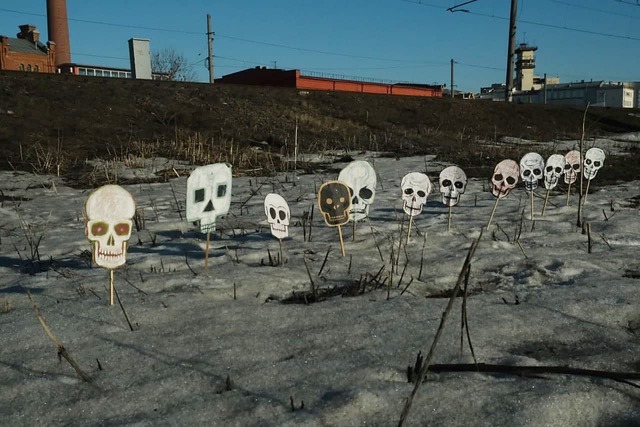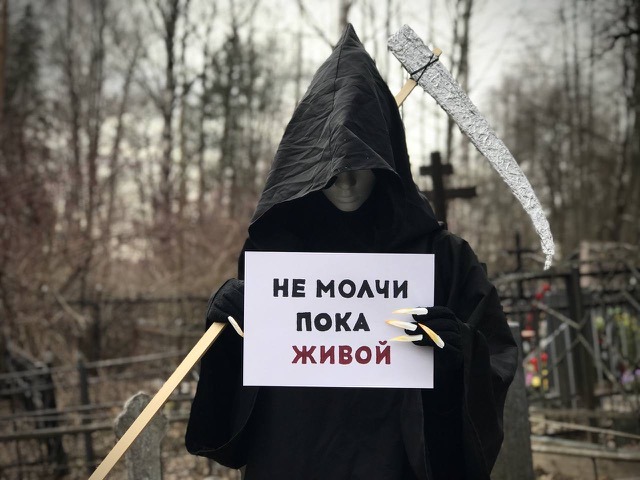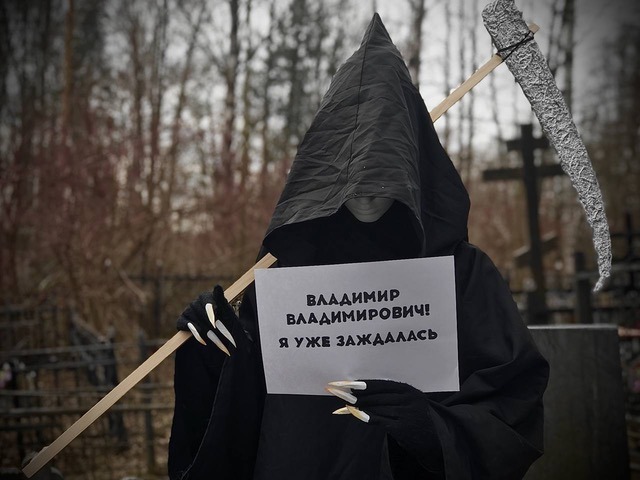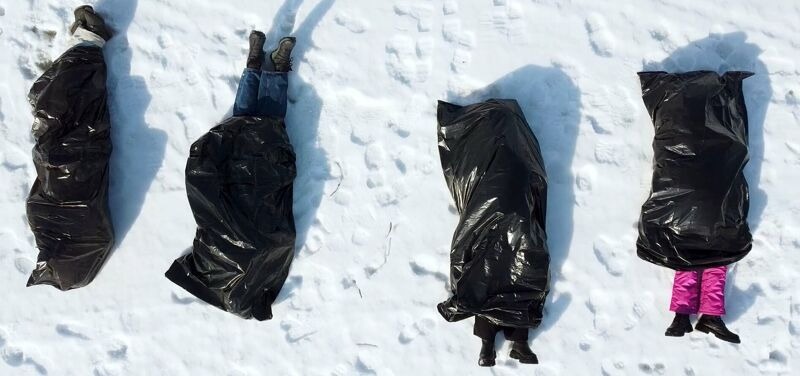
Art of the Necro-Empire
The Party of the Dead against the Fatal Ideology
It takes a certain courage to dive into the coffin, scarlet and silky on the inside – but once you are there, you become pensive and remove yourself from life’s nervous polyrhythm. Its form is pacifying in its predictability. One snowy day last November, I stepped into the coffin and thus pledged allegiance to the Party of the Dead, the coffin’s owners and users, and currently one of the most active and alert art groups in Russia protesting the powers that be and the war in Ukraine. Since the war started, I found myself longing to return to the fake but sweet and temporary release of the funerary ritual. In today’s Russia, for all the people who question humanity’s competence in the art of living, a coffin is the place to be, emotionally.
Protest action by Party of the Dead
The Party of the Dead is discursively sculpted by Maxim Evstropov, a philosopher and noise musician from St Petersburg. In 2020 he outlined a platform for the collective in his endlessly quotable text “Party of the Dead: From Necrorealism to Necroactivism”, which was published in the Moscow Art Journal. Previously Evstropov had been part of the art collective {rodina} (“motherland”), which mocked the increasing isolationism of Russia with acts of subversive affirmation. During “For your safety” (2014), the members of the collective went to a gallery opening and tied everyone with rope, telling people to “keep calm” and remember that “all of this is for your own safety”. “Alas-parade” (2016) was a direct precursor to the Party of the Dead. Several members of {rodina} carried on their passage through the city of St Petersburg a number of pessimistic placards: “Let’s endure this”, “You may not outlive this regime”, and “Everybody’s dead, but some are deader”. The Party of the Dead has taken up the latter message and turned it into what Evstropov calls an “ethical-political program”. The slogans of the Party are more direct. “There are more dead [than living]” is key among them, which is a fact that Evstropov likes to quote in his texts and interviews — according to the latest scientific estimates, about 117 billion people have ever been born on Earth, vastly exceeding the number of those who are currently alive.
"Be alive, take care of our dead". Protest in front of the building of the Ministry of Defense of the Russian Federation by Party of the Dead / Moscow, spring 2022
Similar to {rodina}, the Party of the Dead started out as grotesque and darkly funny parodies of disciplinary strategies in school, the army, and the everyday, but is now retrospectively seen as “critical realism”, a truthful art of a certain era. Moreover, being an “ethical-political program”, it is incredibly effective in the present moment. Before February 24, our generation’s encounters with death mostly came down to the domestic sphere. Immediate relatives died of natural causes and accidents. That is what happened to Evstropov, too, who now says that the Party of the Dead is, in many ways, his trauma management. Being one of the clearest thinkers in contemporary Russia, he transformed his grief into an emancipatory act. Through the Party of the Dead’s incessant picketing, the political space we have found ourselves in is put in high relief.
There were wars waged by Russia in countries far away that employed what American sociologist Martin Shaw calls “risk-transfer militarism”. Somebody fought these wars and many people died, of course, but cultural workers were always just safe enough to discard the possibility of military employment as a means of economic survival. This is not so for many underprivileged parts of Russia, where compensations for war-related disabilities and death can make a family rich. Now, death is everywhere. Most Ukrainians hate it when Russians call them “brotherly people”, noticing that this formula is inherited from the Soviet Union’s patronizing hierarchy of “big” (Russia) and “little brothers” (all other Soviet republics). But Ukraine is a “brotherly”, “sisterly”, “motherly” – and many other instances of blood relations – nation to millions of Russians. It would be nice if every person in the world could invest in every global conflict with horror and activist energy. Some people do, but most have to know someone from the dying side first. The Party of the Dead has always opposed this postmortem nationalism. The dead are everywhere; they are the planet’s biggest and most diverse community. We all will be a part of it some day.
Protest action by Party of the Dead
More importantly, the dead are frequently exploited against their will for the purpose of talking points. “Politicians and priests always declare something in the name of the dead”, Evstropov wrote in the 2020 article. “They appropriate their voices to justify their own miserable present”. “Why not, then, say on their behalf something different – for example, that the state must perish, there is no God, and that every power must fall?”. Evstropov notes that the Party of the Dead was partly inspired by “The Immortal Regiment”, a grassroots movement from Tomsk, Siberia, that participated in Victory Day marches holding photographs of relatives killed in World War II. “The Immortal Regiment” was quickly appropriated by the authorities and turned into another instance of victim-building. In Russia, after their actual death, WWII veterans are conscripted into another army – the battalion led by bellicose politicians. They use the veterans and their heroic avatars, including the Unknown Soldier, to put forth a foreign policy agenda that justifies expansion and threats to other countries on the premise that Russia has a right to govern the lands where its soldiers have spilled their blood.
The Party of the Dead’s activities make this ideology of necro-imperialism clearly visible. It is no coincidence that their demonstrations and actions sometimes look like medieval Europe’s answer to calamity. These are dances of death, a subject for the arts since the first cases of animated side-effects from the plague were recorded. What Russia is going through is a different kind of sickness, though. Namely, the Brown Plague, a term that was coined by gay French reporter Daniel Guérin during his travels through Germany in 1932-1933, and used by Soviet publicists extensively since the end of the WWII without referencing either the source or the sexuality of the author. Evstropov has long observed “the fascist aggregation of a strange collective body” in Russian public politics. He remembers his shock when, after 2014, a rift opened between the formerly united opposition forces. Many of his friends in the experimental music scene thought that the annexation of Crimea was fair and became supporters of the regime. Evstropov explains this as a sort of psychological compensation mechanism. People felt that they had no future. The dead have no future. Why bother fighting? Is there any other way than to join the Necro-Empire’s army? You’re still dead, but at least you have a career.
Feminist Anti-War Movement / action “Mariupol 5000”
And since 2014, the army has been growing fast. Among its military units, the Necro-Empire has formed a regiment of dead male authorities that fight queer theory, gender fluidity, and other talking points of American conservative broadcasting. Hegel and Gogol are mentioned in articles by pundits as examples of “real” culture, as opposed to “fake liberal values”. Moreover, everyone who fears social death in an increasingly diverse culture is welcome to join the Necro-Empire’s army. If you are a soldier, you can help yourself to a ration of free speech and reminisce about “the good old times” when women and minorities knew their place. The Necro-Empire is truly international and attracts many allies to its morbid cause. But their shared objective is not unity but creation of isolated and self-reliant worlds for the French, the Americans, the Hindus, etc. The Party of the Dead aligns itself with most of the emancipatory projects of today, including the feminist and the post-colonial, but “shifts the logic of freedom by bringing it to its logical conclusion”, as Evstropov wrote in 2020. It fights the Necro-Empire’s “pyramids” of decorated dead with empathy towards all who perished. “The choices of possible action look like this: 1) to become a “carrier” for the dead, hospitable to ghosts; 2) to live in death and with the dead; 3) to die, become and be dead”, Evstropov elaborates. It all sounds like the work of historians, philosophers, and critical and creative thought in general. We must listen to the dead with utmost attention, but what can they possibly talk about? “They all say everything and at once”, he writes, “Their words are a background to our existence”. That is why there is also a transgressive element to the dead, and not only because they lie beyond the path of the living. Here, according to Evstropov’s sketchy proposal outlined in an unpublished talk, to think of the “queerness of the dead” relates to Ukrainian artist Nikita Kadan’s “mass grave queer”, where bodies are entwined in a final embrace.
In his interview for the now-blocked website Sibir.Realii, Evstropov sums up the Necro-Empire’s grip on Russian society: “The dead are not allowed to be dead. And those who are living are not allowing themselves to be alive”. In life, The Party of the Dead emancipates people from a fearful existence and provides a space in which to act as representatives of a diverse majority, silent but not voiceless. To enter the Party of the Dead is liberating in other ways, too: the guilt and shame that Russians in the opposition feel are signifiers of powerlessness. Those who have thought that their joys and life-sharing activities in charity, education, and volunteering advance Russia towards a more just and open society have discovered that the root of all pleasure is the absence of fear. To act as if you’re dead means to be open to a multitude of futures, as outlined in Stoic philosopher Epictetus’ “The Art of Living”: “I must die. If the time is now, then I’m ready. If not now, but after a short time, I’ll have something to eat because it’s the lunch hour. After that, I’ll die. How? Like a man who gives up what belongs to another”.
An anonymous collective “Nevoina” (“Notwar”) / action “Giving Voice to the Dead”
Of course, the Party of the Dead is only one of the alternatives to the Necro-Empire's ideology. In Samara, an anonymous collective that goes by the name “Nevoina” (“Notwar”) orchestrated “Giving Voice to the Dead”, an action that took place on February 28 in which 26 people lay on the snow in black plastic bags. After the killings in Kyiv’s satellite town of Bucha became public, a number of anonymous activists recreated the poses of the victims in the streets of Moscow and Kransodar. It also stands to reason that the feminist and queer initiatives are very powerful and articulate at the moment. They were quick to point out that the war is a direct consequence of the increasingly violent male domination in Russian society. People who shed blood once a month stand against people who draw blood at will in bouts of patriarchal violence at home and in the street. People who care stand against people who dismiss feelings that betray even trace amounts of weakness. One of the most remarkable images from the nationwide protest on March 6 was a video of an unknown protester glitter-bombing police officers who apprehended him – a tactic that references American actions against politicians who oppose gay rights.
Feminist Anti-War Movement / action “Mariupol 5000”
Feminist Anti-War Movement, founded by Daria Serenko, one of the staunchest critics of the regime, was one of the first collective efforts to fight military aggression. In their action titled “Mariupol 5000” they have called on everyone who opposes the war to install makeshift crosses in their cities with tablets that reference the Russian bombings of the Ukrainian city, an attack that has left almost 5000 dead. “Women in Black”, another Feminist action, resulted in thousands of activists standing in individual pickets with flowers in their hands, mourning for the casualties of war – a direct reference to the original action by Israeli women protesting Israel’s military crimes in Palestine. The Russian version is documented in photographs and Katya Muromtseva’s stark watercolors that transform the original images into an alphabet of protest. The faces are either erased, cut out of the frame, or camouflaged: if you have no features, you remain nameless and invisible to the Necro-Empire but still get the message out.
Katya Muromtseva. Action “Women in Black”
The Necro-Empire is this historical period’s tipping point, a collection of complex entanglements of resentment, fear, and powerlessness of the abandoned that begets violence. Unlike the Soviet Union, which saw itself as a modernizer, the Necro-Empire has no features of effectiveness that can be disguised as a gift to an underdeveloped community. It comes with no system of governing that can be seen as a working alternative to the state dynamics Ukraine is heading towards. The official propaganda is using a lot of deeply cynical reasoning to justify the war. But even the most blood-thirsty pundits are not saying that Russia is about to install a more advanced infrastructure and/or bureaucracy. “Ukraine does not exist”, openly says the Necro-Empire through one of its Presidents, and then proceeds to prove the lie by murder. Death is this empire’s only casus belli. Silence is the Necro-Empire’s only capital, and our shares are morally and economically cancelled.
Title image: “Russian spring snowdrops”, installation by Party of the Dead / Petersburg, March 2022